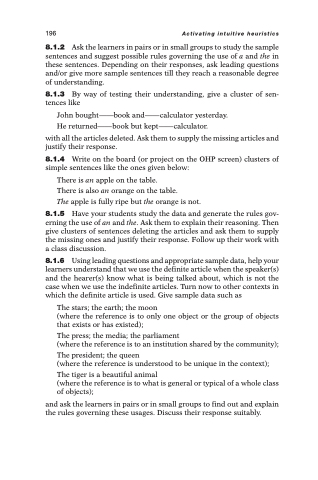Page 208 - Beyond Methods
P. 208
196 Activating intuitive heuristics
8.1.2 Ask the learners in pairs or in small groups to study the sample sentences and suggest possible rules governing the use of a and the in these sentences. Depending on their responses, ask leading questions and/or give more sample sentences till they reach a reasonable degree of understanding.
8.1.3 By way of testing their understanding, give a cluster of sen- tences like
John bought——book and——calculator yesterday. He returned——book but kept——calculator.
with all the articles deleted. Ask them to supply the missing articles and justify their response.
8.1.4 Write on the board (or project on the OHP screen) clusters of simple sentences like the ones given below:
There is an apple on the table.
There is also an orange on the table.
The apple is fully ripe but the orange is not.
8.1.5 Have your students study the data and generate the rules gov- erning the use of an and the. Ask them to explain their reasoning. Then give clusters of sentences deleting the articles and ask them to supply the missing ones and justify their response. Follow up their work with a class discussion.
8.1.6 Using leading questions and appropriate sample data, help your learners understand that we use the definite article when the speaker(s) and the hearer(s) know what is being talked about, which is not the case when we use the indefinite articles. Turn now to other contexts in which the definite article is used. Give sample data such as
The stars; the earth; the moon
(where the reference is to only one object or the group of objects that exists or has existed);
The press; the media; the parliament
(where the reference is to an institution shared by the community);
The president; the queen
(where the reference is understood to be unique in the context);
The tiger is a beautiful animal
(where the reference is to what is general or typical of a whole class of objects);
and ask the learners in pairs or in small groups to find out and explain the rules governing these usages. Discuss their response suitably.


